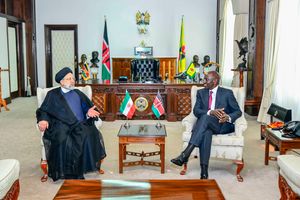
Ntinyika Primary School teacher Mike Solitei teaches social studies to Grade 6 at the school on September 21, 2023.
| Francis Nderitu | Nation Media GroupNews
Premium
Lack of funds ‘elephant in the room’, claims don on junior school roll-out
What you need to know:
- Junior school was conceptualised in the Basic Education Curriculum Framework.
- Learners in Grade Seven have been wearing different uniform from those in the lower grades.
Sh14.7 billion has already been spent on junior schools but questions still abound regarding the effectiveness of implementation of the newest segment in the education system under the competency-based curriculum (CBC).
The money is expected to double when the second class transitions to junior school but inadequate staffing and retooling of teachers, infrastructure challenges and financing top the list of issues that stakeholders told Nation stand in the way of successful implementation. Political interests were also cited as a factor in the reform process.
“In the formulation and conceptualisation of CBC, we were hoping that, when learners joined junior school, we would be able to pick out their leanings. So, we’d be able to see whether they’re scientifically oriented, whether they’re in the humanities, whether they’re in applied subjects or whether they’re good in performing arts or sports.”
“Then we’d channel them into different centres of learning. We were going to call them centres of learning, not really schools. It was hoped that we’d be producing more productive manpower for the country,” Daystar University Vice-Chancellor Laban Ayiro said.
Junior school was conceptualised in the Basic Education Curriculum Framework (BECF) that shortened the time learners spent in primary school by two years and lengthened secondary school study by two years.
Therefore, the structure changed from 8-4-4 to 2-6-3-3-3. Initially, it was referred to as junior secondary school (JSS) before the term secondary was dropped on the recommendation of the Presidential Working Party on Education Reforms (PWPER).
However, confusion always dogged the place of the three years of junior school after six years of primary schooling. In 2020, a task force on CBC that was led by Prof Fatuma Chege recommended the domiciling of JSS in secondary schools.
“It is at JSS that learners will need to deepen their understanding of the broad CBC curriculum and choose the pathways and tracks to follow in senior secondary school. The primary school level lacks capacity, both in human resource and infrastructure (especially for teaching sciences), to facilitate the expected depth of engagement with the JSS CBC content,” a report by the task force reads.
“Further, domiciling JSS at secondary school level will optimise teacher utilisation as they will teach at both junior and senior secondary school levels. This recommendation is aligned with [the practice in] other countries within the East African Community and international best practices,” the report observed.
The Ministry of Education, then under Prof George Magoha, embarked on an ambitious project to expand the infrastructure in secondary schools and build over 20,000 classrooms. However, the placement was contested by Kenya National Union of Teachers, which draws the majority of its membership from primary schools, as well as the Kenya Primary Schools Heads Association.
On the other hand, the Kenya Union of Post Primary Education Teachers and the Kenya Secondary Schools Heads Association argued for junior school to be placed in secondary schools.
In December last year, the PWPER recommended the domiciling of junior school in primary schools, which were unprepared for the transition. The ministry developed guidelines for establishment of the new segment.
However, textbooks were delivered late to schools, some as late as in second term. This has delayed syllabus coverage across all the public schools that Nation sampled. However, learners in private schools are way ahead as parents bought the books at the beginning of Term One. The institutions also lack laboratories for practical subjects.
“The elephant in the room has been funding. Our research found that, to fund the first four grades [of primary school], the government should pump into the education sector about Sh360 billion for the first year. We advised that this should be done progressively as we built the capacity of the teachers and improved the infrastructure. Our economic base wouldn’t support such an education system and that’s why we’re in a kind of quagmire,” Prof Ayiro said. He led a team of external reviewers in 2018 that evaluated the piloting of CBC across the 47 counties.
Dr Julius Jwan, who served as director of the Kenya Institute of Curriculum Development when the BECF was developed and later principal secretary for Basic Education, told Nation that the change to take junior school suits the current circumstances.
“We never took time to let people understand how we wanted the basic education curriculum to develop. We realised that learners needed to spend more time with parents.”
“We needed to deconstruct the idea of secondary school. We’re one of the few countries that conceive secondary education as being in a boarding school but again, we couldn’t waste those facilities,” Dr Jwan said.
He added that teachers in primary schools can deliver the junior school curriculum if empowered through in-service training.
“Once you’re trained as a teacher, there are certain fundamentals that remain the same. Teachers know the various methods of teaching that they’re supposed to apply. Whether the retooling was effectively done or not is because they already have the generic knowledge as teachers but these things are political and tensions followed. But don’t ignore the fact that educational reforms anywhere in the world are both technical and political,” he said.
The two underscored the place of politics in curriculum reform. Whereas former President Uhuru Kenyatta aimed at leaving a legacy of education reform through CBC, his successor William Ruto appears to have reversed many of the decisions he had made.
“Education is a highly political engagement because it affects every single household in the republic. The right politics can give momentum to reforms but, in anything we do, the critical variable is the economics of that undertaking,” said Dr Jwan.
“Education and politics are thoroughly aligned. Education is one area where everyone has an opinion because it affects all aspects of society and that, therefore, requires informed political intervention,” noted Prof Ayiro.
According to Dr Emmanuel Manyasa, the executive director of Usawa Agenda, the arguments against junior secondary were faulty, especially on age of learners since there is no requirement that secondary education be in a boarding setting.
“The previous regime has to be credited for development of the CBC and for being bold to change the curriculum. I think they failed to prepare for junior school and initially there wasn’t a clear guideline in terms of its domiciling,” said Dr Manyasa.
Headteachers who spoke to Nation said there have been conflicting communication and cited a new directive to discontinue new uniforms that learners in junior school have been wearing since the schools will now be managed as one. Learners in Grade Seven have been wearing different uniform from those in the lower grades.
“Headteachers are instructed not to instruct parents to buy new uniform for Grade Seven currently in Grade Six,” a communication by a sub-county director seen by Nation reads.





